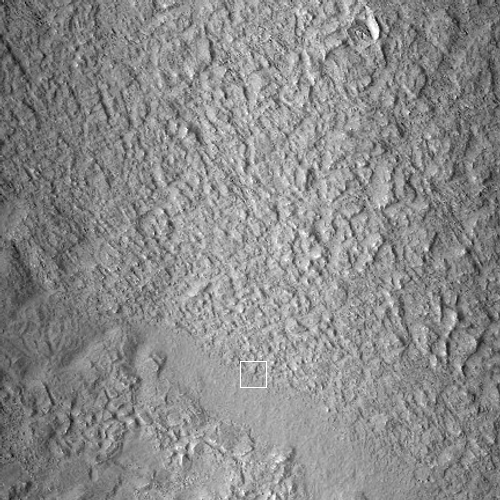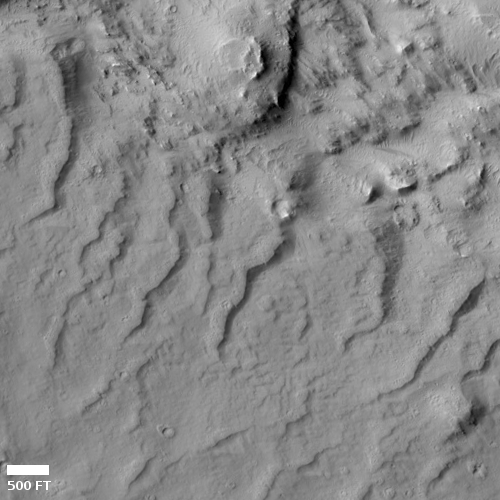Rivulets in Martian lava

Today’s cool image is another example of scientists finding cool things hidden within distant pictures. The small white rectangle on the overview map to the right shows us where we are heading, to the severely eroded lava plains to the southwest of Mars’ largest volcano, Olympus Mons.
The white spot is about 500 miles from the caldera of Olympus Mons. In elevation it sits about 58,000 feet below that caldera, more than twice the height of Mt. Everest. Yet, despite these great distances, the material at that white rectangle was almost certainly laid down during an eruption from Olympus Mons, thus illustrating the gigantic scale of volcanic events on Mars. Because of the red planet’s light gravity, about 38% of Earth’s, not only can lava flow farther, it does so much faster.
The second image below is a wide angle photo taken by the context camera on Mars Reconnaissance Orbiter (MRO) in January, 2012, rotated, cropped, expanded, and enhanced to post here.
This context camera image reveals the complicated and very rough terrain in this region, often interspersed with smooth areas such as flat area near the bottom of the picture. I think the downhill grade in this photo is to the north, but am not certain.
The roughness of the terrain suggests, but does not prove, that this is old lava, because it is no longer smooth and has had time to erode.
The white rectangle shows the location of the high resolution image taken by MRO, taken on June 10, 2021. That section can be seen below and to the right, rotated and cropped to post here.
I suspect this photo, which covers a larger area than the section I have cropped, was chosen because scientists wished a closer look at that smooth area. The cropped section however focuses in on what I suspect was an unexpected find, the series of meandering rivulets that seem to descend from that smooth area into the badlands to the north. These rivulets are not visible in the context camera image.
What caused them? Water? Glaciers? Lava? Your guess is as good as mine. Though this is now in the dry equatorial region, that wasn’t always the case as Mars’s rotational tilt shifted back and forth, so water and ice might have once dominated this terrain. Such processes cannot be dismissed as a cause of such features.
The terrain surrounding Olympus Mons for many hundreds of miles suggest many eruptions over billions of years, with the youngest suspected to be in its northwest slopes between two and a hundred million years ago. Disentangling the history of all those events however will required a lot more research, most of which will have to be done in situ, on Mars.
For other posts on the regions surrounding Olympus Mons, see these:
On Christmas Eve 1968 three Americans became the first humans to visit another world. What they did to celebrate was unexpected and profound, and will be remembered throughout all human history. Genesis: the Story of Apollo 8, Robert Zimmerman's classic history of humanity's first journey to another world, tells that story, and it is now available as both an ebook and an audiobook, both with a foreword by Valerie Anders and a new introduction by Robert Zimmerman.
The print edition can be purchased at Amazon or from any other book seller. If you want an autographed copy the price is $60 for the hardback and $45 for the paperback, plus $8 shipping for each. Go here for purchasing details. The ebook is available everywhere for $5.99 (before discount) at amazon, or direct from my ebook publisher, ebookit. If you buy it from ebookit you don't support the big tech companies and the author gets a bigger cut much sooner.
The audiobook is also available at all these vendors, and is also free with a 30-day trial membership to Audible.
"Not simply about one mission, [Genesis] is also the history of America's quest for the moon... Zimmerman has done a masterful job of tying disparate events together into a solid account of one of America's greatest human triumphs."--San Antonio Express-News

Today’s cool image is another example of scientists finding cool things hidden within distant pictures. The small white rectangle on the overview map to the right shows us where we are heading, to the severely eroded lava plains to the southwest of Mars’ largest volcano, Olympus Mons.
The white spot is about 500 miles from the caldera of Olympus Mons. In elevation it sits about 58,000 feet below that caldera, more than twice the height of Mt. Everest. Yet, despite these great distances, the material at that white rectangle was almost certainly laid down during an eruption from Olympus Mons, thus illustrating the gigantic scale of volcanic events on Mars. Because of the red planet’s light gravity, about 38% of Earth’s, not only can lava flow farther, it does so much faster.
The second image below is a wide angle photo taken by the context camera on Mars Reconnaissance Orbiter (MRO) in January, 2012, rotated, cropped, expanded, and enhanced to post here.
This context camera image reveals the complicated and very rough terrain in this region, often interspersed with smooth areas such as flat area near the bottom of the picture. I think the downhill grade in this photo is to the north, but am not certain.
The roughness of the terrain suggests, but does not prove, that this is old lava, because it is no longer smooth and has had time to erode.
The white rectangle shows the location of the high resolution image taken by MRO, taken on June 10, 2021. That section can be seen below and to the right, rotated and cropped to post here.
I suspect this photo, which covers a larger area than the section I have cropped, was chosen because scientists wished a closer look at that smooth area. The cropped section however focuses in on what I suspect was an unexpected find, the series of meandering rivulets that seem to descend from that smooth area into the badlands to the north. These rivulets are not visible in the context camera image.
What caused them? Water? Glaciers? Lava? Your guess is as good as mine. Though this is now in the dry equatorial region, that wasn’t always the case as Mars’s rotational tilt shifted back and forth, so water and ice might have once dominated this terrain. Such processes cannot be dismissed as a cause of such features.
The terrain surrounding Olympus Mons for many hundreds of miles suggest many eruptions over billions of years, with the youngest suspected to be in its northwest slopes between two and a hundred million years ago. Disentangling the history of all those events however will required a lot more research, most of which will have to be done in situ, on Mars.
For other posts on the regions surrounding Olympus Mons, see these:
On Christmas Eve 1968 three Americans became the first humans to visit another world. What they did to celebrate was unexpected and profound, and will be remembered throughout all human history. Genesis: the Story of Apollo 8, Robert Zimmerman's classic history of humanity's first journey to another world, tells that story, and it is now available as both an ebook and an audiobook, both with a foreword by Valerie Anders and a new introduction by Robert Zimmerman.
The print edition can be purchased at Amazon or from any other book seller. If you want an autographed copy the price is $60 for the hardback and $45 for the paperback, plus $8 shipping for each. Go here for purchasing details. The ebook is available everywhere for $5.99 (before discount) at amazon, or direct from my ebook publisher, ebookit. If you buy it from ebookit you don't support the big tech companies and the author gets a bigger cut much sooner.
The audiobook is also available at all these vendors, and is also free with a 30-day trial membership to Audible.
"Not simply about one mission, [Genesis] is also the history of America's quest for the moon... Zimmerman has done a masterful job of tying disparate events together into a solid account of one of America's greatest human triumphs."--San Antonio Express-News




An important objective once we geologists get there will be determining the composition of the far-flowing lava. Here, some types flow in an almost laminar fashion, typified by ‘pahoehoe’, the ropy material common on Hawaii. Others, like we’re seeing in the Canary Islands, flow more slowly, with the flow’s leading edge a slow-moving wall of clinky molten rock (Hawaiian ‘aa’). Slight differences in composition and the concentration of volatiles in solution (water and other compounds) makes a huge difference in flow characteristics.